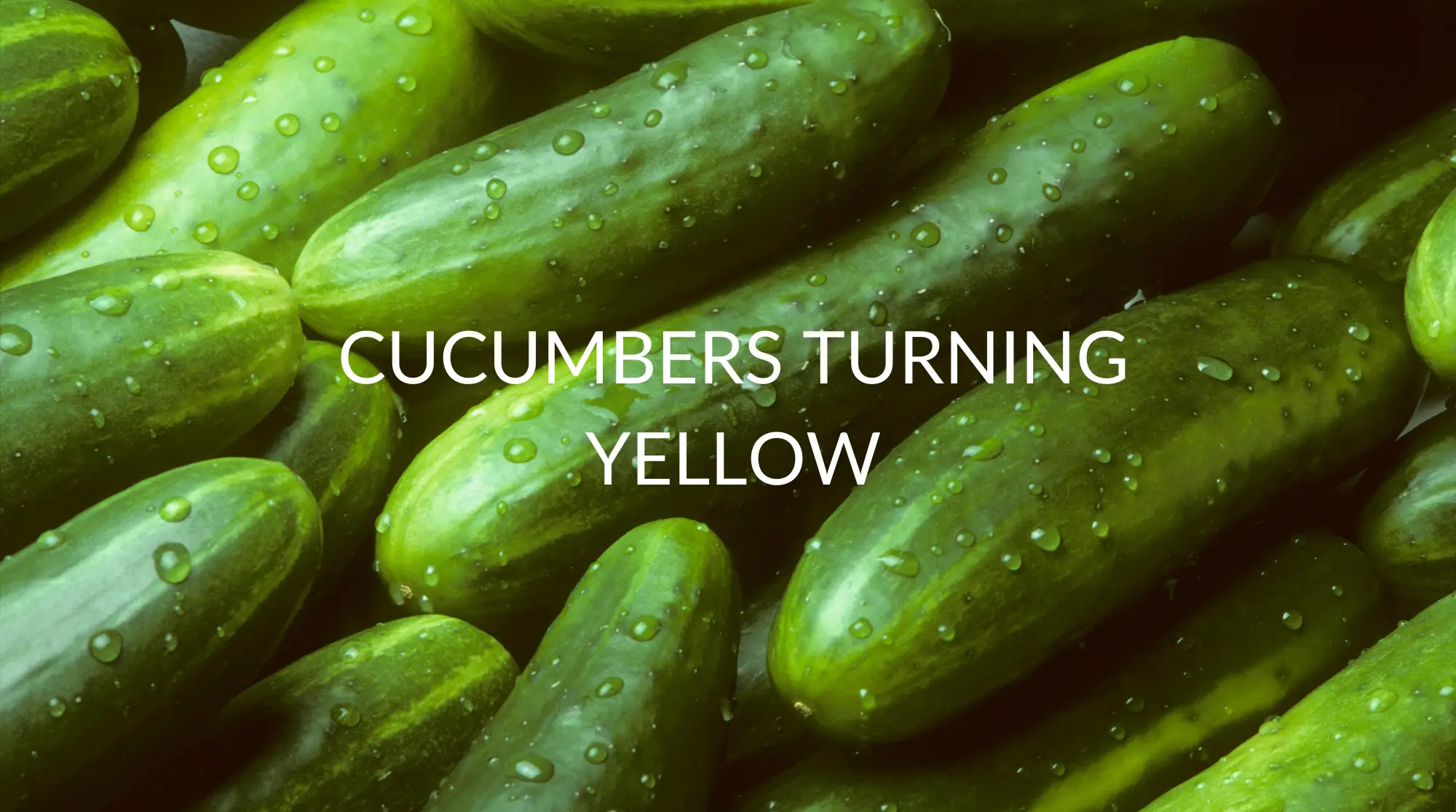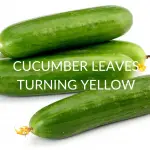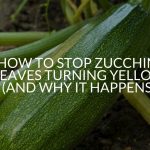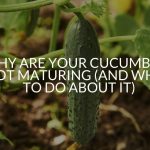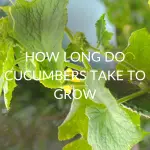It’s disheartening to dedicate so much time and effort to cultivating a beautiful garden, only to have our plants turn out unusable. If you have planted cucumbers and notice your cucumbers turning yellow, what can you do?
Yellow cucumbers aren’t always a bad thing, but more often than not, your cucumbers turning yellow are a sign that something has gone wrong. Preventing your cucumbers from yellowing is fairly simple. Additionally, knowing which yellow cucumbers are and aren’t edible is important, so you keep yourself safe as you harvest your plant.
Why Are My Cucumbers Turning Yellow?
If you notice a few of your cucumbers have turned yellow, there are a few factors that could be the culprit. Sometimes, you have to go through a process of elimination to determine what the cause was for your particular crop.
Your Cucumbers Are Too Ripe
Finding yellow cucumbers often means that it’s too late to harvest an edible cucumber. Without paying close attention to cucumber plants once harvest time approaches, it seems as though cucumbers can change color quite quickly.
Color starts to fade from cucumbers the longer they sit on the vine, making cucumbers go from a dark green to yellow. Overripe cucumbers may also change shape and size.
Your Cucumbers Need More Air
Cucumber plants can grow to be quite boisterous, so how you plant them is important to ensure they get enough air. If your plant doesn’t have enough room to spread out and breathe, it may end up turning yellow due to inadequate conditions. Furthermore, lack of air can lead to fungal infections.
Your Cucumbers Have Been Overwatered
Cucumber plants do need frequent watering, but that doesn’t mean these plants are privy to becoming overwatered. It can be difficult for cucumber plants to pass nutrients from the soil around the plant when there’s too much water getting in the way.
Roots and vines can get clogged, stopping water from moving and leaving your cucumbers very thirsty. Consistent overwatering can cause damage to your cucumber plant that can be difficult to turn around.
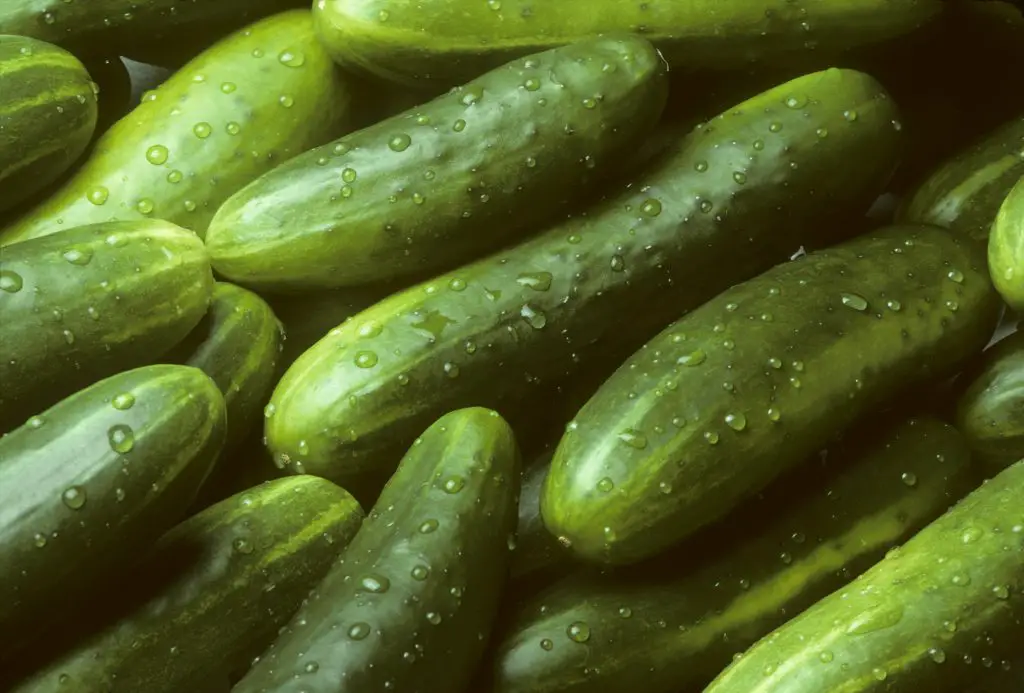
Your Cucumbers Are Sick
Cucumber mosaic virus is one of the most common causes of illness for cucumbers, and it causes them to develop unsightly yellow coloring. The virus is transmitted through aphid bites, making it crucial to try and avoid pests getting into your cucumber plants.
The Soil Lacks Nutrients
Soil with adequate drainage and a solid amount of nutrients is needed for healthy cucumber plants. Should your plant not get enough nutrients from the soil, your cucumbers can end up turning yellow before they even have the chance to become ripe.
You don’t want to over-fertilize, but know that adding fertilizer to the soil once before planting isn’t going to be enough to keep your cucumber plants healthy.
Your Cucumbers Need Pollen
Not only do flowers need pollination to bloom, but cucumber plants also need their small flowers pollinated by bees so they can grow. Without the right amount of pollen, water, and nutrient-dense soil, your cucumbers will look yellow and sad and may even just fall off the vine.
Why Are My New Cucumbers Turning Yellow?
If you’ve planted cucumbers for the first time and you’re starting to notice yellow cucumbers, it can be quite frustrating. There is a learning curve involved with growing some plants for the first time. If a newer plant is starting to spawn yellow cucumbers, it could be because of one of the following reasons.
Cucumbers Weren’t Harvested In Time
Even if you planted your first cucumber crop this year, if you don’t manage to pick your cucumbers when they are finished growing, they will start to go yellow, eventually wilting. Once you notice your cucumbers are lush green and firm to the touch, you should pluck them off the plant.
Not Enough Pollinators
Cucumber plants benefit from pollinators coming by, but if there aren’t enough around, your cucumbers may not get a chance to flourish. Cucumber plants usually grow flowers, both male and female. The male flowers should be removed, but the female flowers need to stay so that pollinators are attracted to your cucumber plant.
Insufficient Nutrients
Not feeding your cucumber plants with nutritious soil and fertilizer can cause them to yellow. As previously mentioned, cucumbers might go yellow prematurely should they lack the right nutrients to blossom. You might notice that your cucumbers not only went yellow, but they barely grew as well.
You Bought Yellow Cucumbers
Some people may not realize that there is actually a variety of cucumbers that is naturally yellow. As such, one might purchase a random bag of cucumber seeds, not realizing that they are meant to grow into a yellow vegetable.
Lemon yellow cucumbers tend to be the most commonly found yellow cucumber, but there are also yellow submarines and salt and pepper cucumbers that typically range between bright yellow and light yellow. One of the easiest ways to know if your cucumbers are supposed to be yellow is how many cucumbers have grown yellow.
Improper Watering
How often you water your cucumber plants is just as important as the method you use to water them. When watering your cucumber plants, you need to pour water into the soil slowly, so water gets directed appropriately. Otherwise, cucumbers could go yellow due to improper moisture levels.
It is possible for too little water to turn cucumbers yellow, though more often than not, they’ll go brown. As mentioned, too much water will disrupt your cucumber plants’ naturally green luster. In especially hot weather, you can lightly spritz your plant with a spray bottle of water to make sure they don’t dry out.
Can You Eat Yellow Cucumbers?
It’s not recommended that anyone eat an overripe cucumber. They aren’t necessarily dangerous unless they’ve started to degenerate, but they don’t taste very good. A yellow cucumber is often very bitter and soft, making it a very unappetizing vegetable.
Should you happen to have planted a variety of cucumber that is meant to be yellow, whether accidentally or on purpose, you can go ahead and consume those. They are not bitter and are actually quite delicious and uniquely flavored compared to your typical green cucumber.
Some people enjoy the taste of overripe cucumbers, especially if they are pickled or used in a relish that requires a bitter flavor profile. They do not have that signature sweet, fragrant, juicy flavor that you’re used to with cucumbers, so chances are you’ll want to find another use for those yellow cucumbers.
How To Prevent Cucumbers From Turning Yellow
When your cucumbers have turned yellow, it’s too late to do anything about it. However, you can prevent future yields from yellowing by doing everything you can to avoid anything nefarious developing in your garden.
Harvest Cucumbers On Time
You should keep track of when you planted your cucumbers so you can be sure to harvest them on time. Typically, cucumbers will be ready between 50 and 70 days after they are planted. Once the timeframe for harvest starts approaching, it’s worth taking a few minutes each day to go through your plant, picking off any cucumbers that look green and firm.
Plant Pollinators
Adding a few pollinators to your garden will attract bees to your garden, thus encouraging them to pollinate a cucumber plant adequately. They can also add some beautiful color to your garden while aiding in a small way the conservation of vulnerable honeybees.
Plant Companion Plants
Companion plants not only help attract pollinators to your cucumber plants, but many plants known as companion plants will also help to deter pests that can cause serious damage to your cucumbers. Some edible companion plants include peas, dill, and green beans.
Fertilize Appropriately
The best course of action to ensure cucumbers get enough food is to add either fertilizer or compost once the cucumbers are planted. Once cucumbers are ready to harvest, you can add more fertilizer to the soil. When the growing season comes back, you can fertilize about once a month to keep your cucumber plant healthy.
Rotate Plants Every Couple Of Years
Soil quality can start to diminish over time even if you continue to top it up and add fertilizer. After a couple of years of a successful harvest, consider starting a new cucumber plant in a different location.
This can help to prevent yellow cucumbers from growing due to a lack of nutrients in the soil. Additionally, it’s the best way to prevent any type of disease your cucumbers may have caught from potentially reappearing in your new crop.
Plant Your Cucumbers Strategically
Since poor air circulation is one of the causes of yellowing cucumbers, how you plant your cucumbers can help you prevent a repeat occurrence, especially if you have a small garden. Keeping plants spaced out can prevent cucumbers from crowding each other and depriving each other of oxygen and sunlight.
One way to mitigate this issue is to plant your cucumbers to grow along a trellis that extends upward. This also helps keep pests away by helping your cucumbers grow off the ground and stay that way.
What To Do With Yellow Cucumbers
Yellow cucumbers are not unsafe or harmful in and of themselves unless they have a virus or disease. Even if your cucumbers went yellow for innocent reasons such as overwatering, you’d want to pluck them off to give the rest of the plant a chance to continue on.
Yellow cucumbers free of disease can go into a compost bin, or they can be broken up and put back into a garden. They are a really great source of nitrogen which your garden loves. Should the yellow cucumbers have a disease, you’ll want to find a way to destroy them to avoid that disease spreading based on what your locality allows.
You can also harvest the seeds of cucumbers that have turned yellow due to overripeness, and you can either pass them on or use them for your garden next year. If you want to harvest some seeds out of overripe cucumbers, keep them on the vine for a little longer so that the seeds can fully mature before you pick them out of the cucumbers.
Frequently Asked Questions
Sometimes particular circumstances surrounding your yellowing cucumbers can leave you confused about what went wrong.
Why Are My Cucumbers Turning Yellow And Not Growing?
If cucumbers remain small and turn yellow, there’s a good chance that your cucumber plant was not properly pollinated. Cucumber plants will grow small flowers, and the female flowers need to be pollinated in order for these plants to flourish to their full potential. Male flowers are not needed, so those should be picked off.
To tell the difference between male and female cucumber flowers, look for a small round sac-like growth on the back of the flower. If you see one of these growths, you’ve found yourself a female cucumber flower. If one isn’t present, pluck that flower off.
Why Are My Cucumbers Turning Yellow On The Vine?
Once cucumbers become ripe, if they aren’t harvested, they are going to continue to mature. As a result, they will start to turn yellow on the vine. Essentially, the cucumber is naturally getting itself ready to make seeds for next year since it wasn’t harvested. This process causes the chlorophyll in cucumbers to halt production, which is what gives cucumbers their gorgeous green color.
Recap
In most cases, yellow cucumbers are the result of cucumbers left on the vine for too long or cucumber plants receiving too much water. Cucumbers might also turn yellow if they aren’t getting enough food from the soil. In these scenarios, you can still utilize parts of these cucumbers, but they aren’t very tasty.
Should you find that your cucumbers turn yellow for a more serious reason, such as pests or disease, it’s time to say goodbye to those cucumbers and possibly, the entire plant. If you want to give planting cucumbers a second go next year, it’s worth finding a new spot to grow these deliciously refreshing vegetables.

